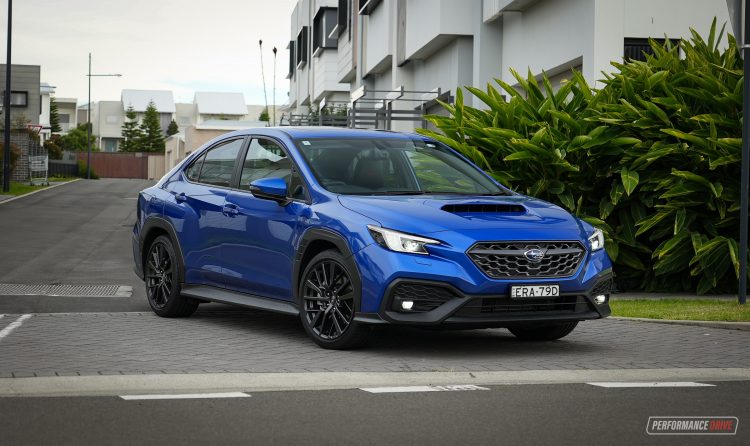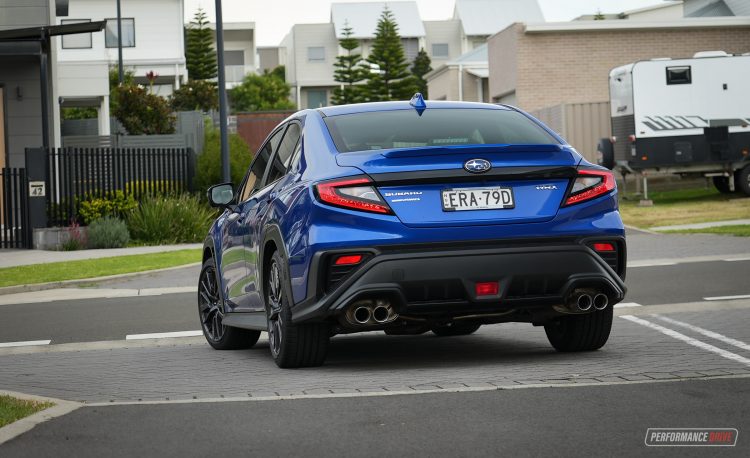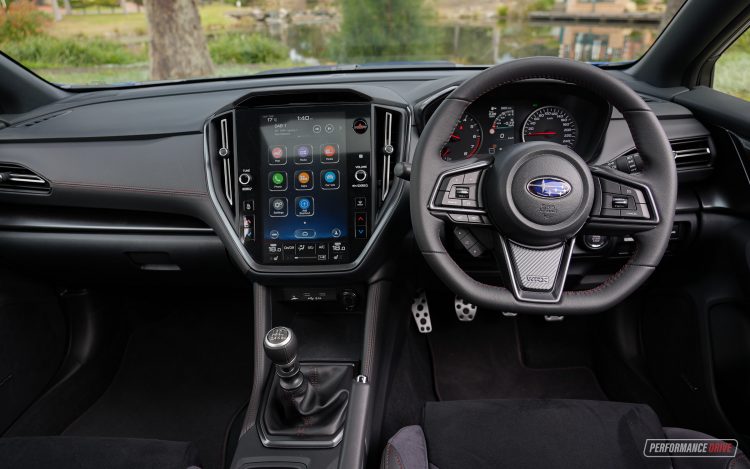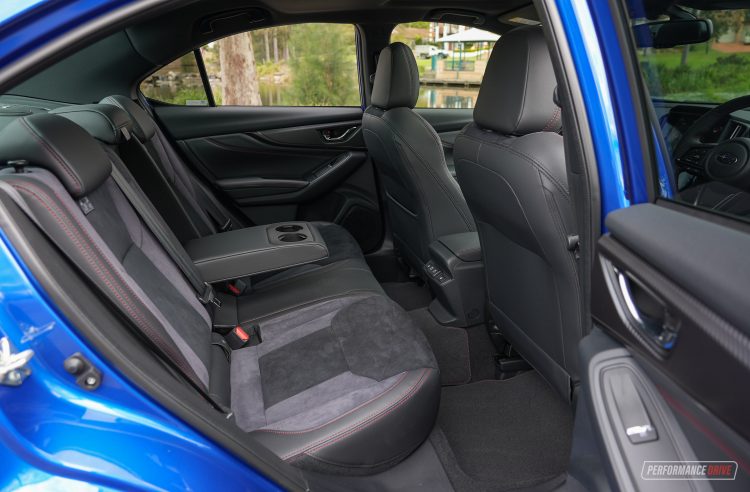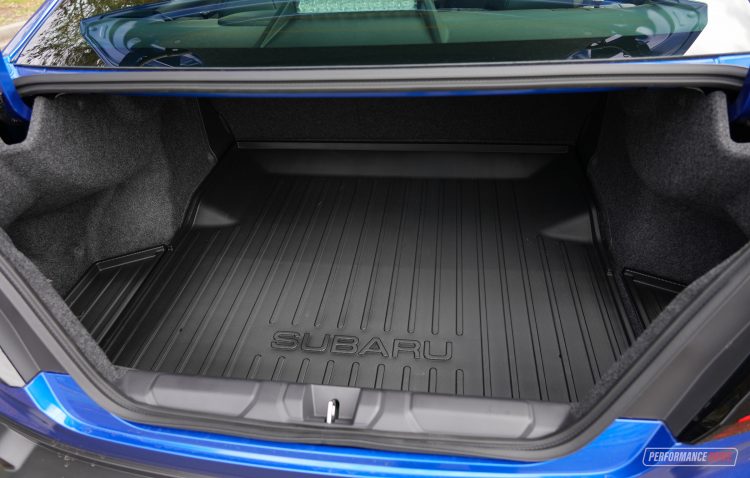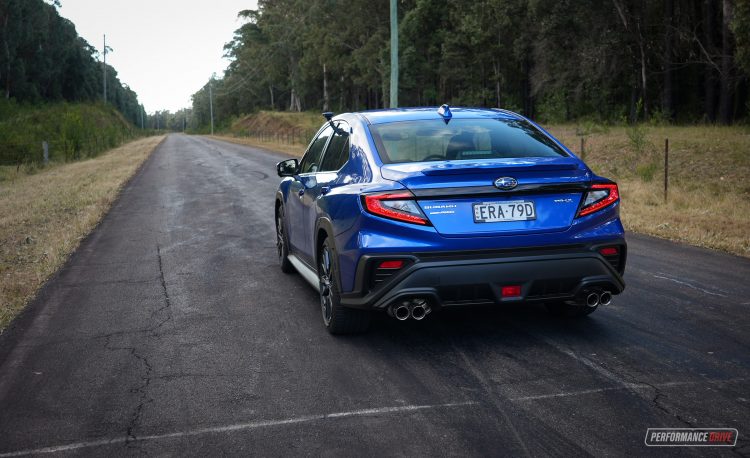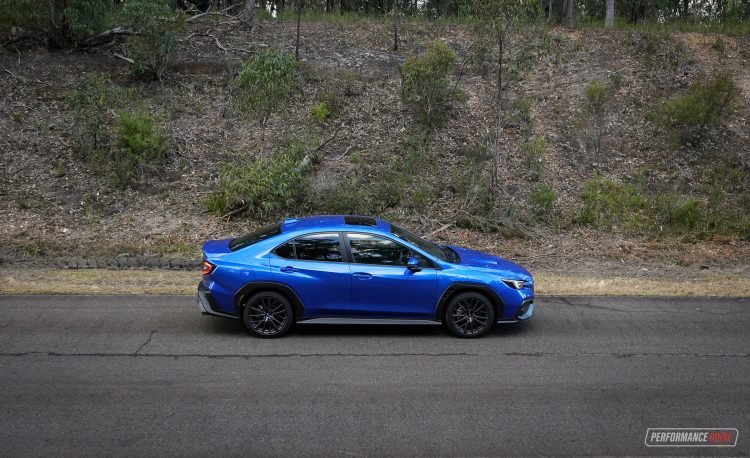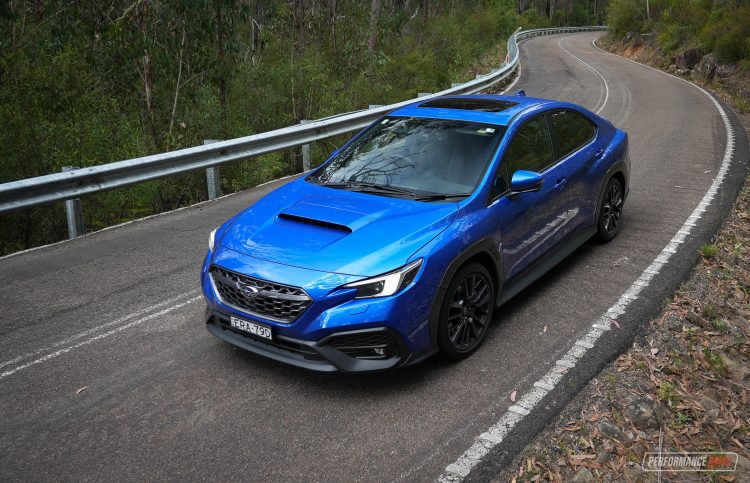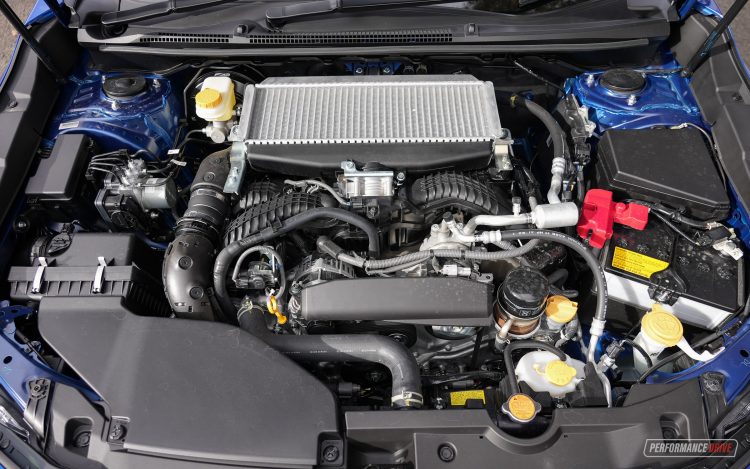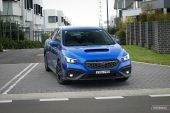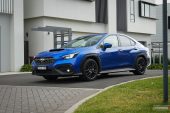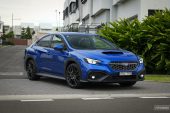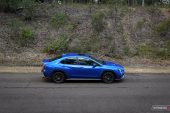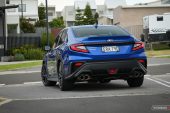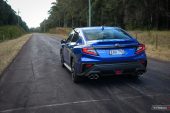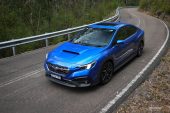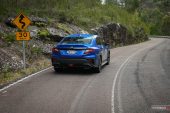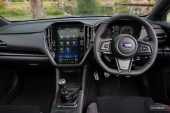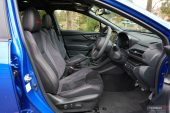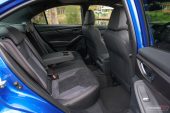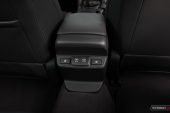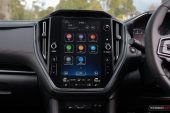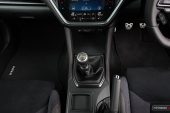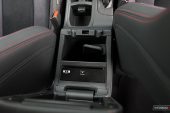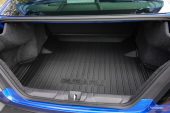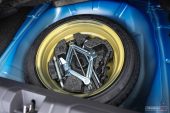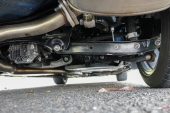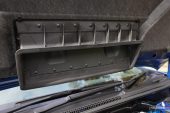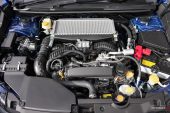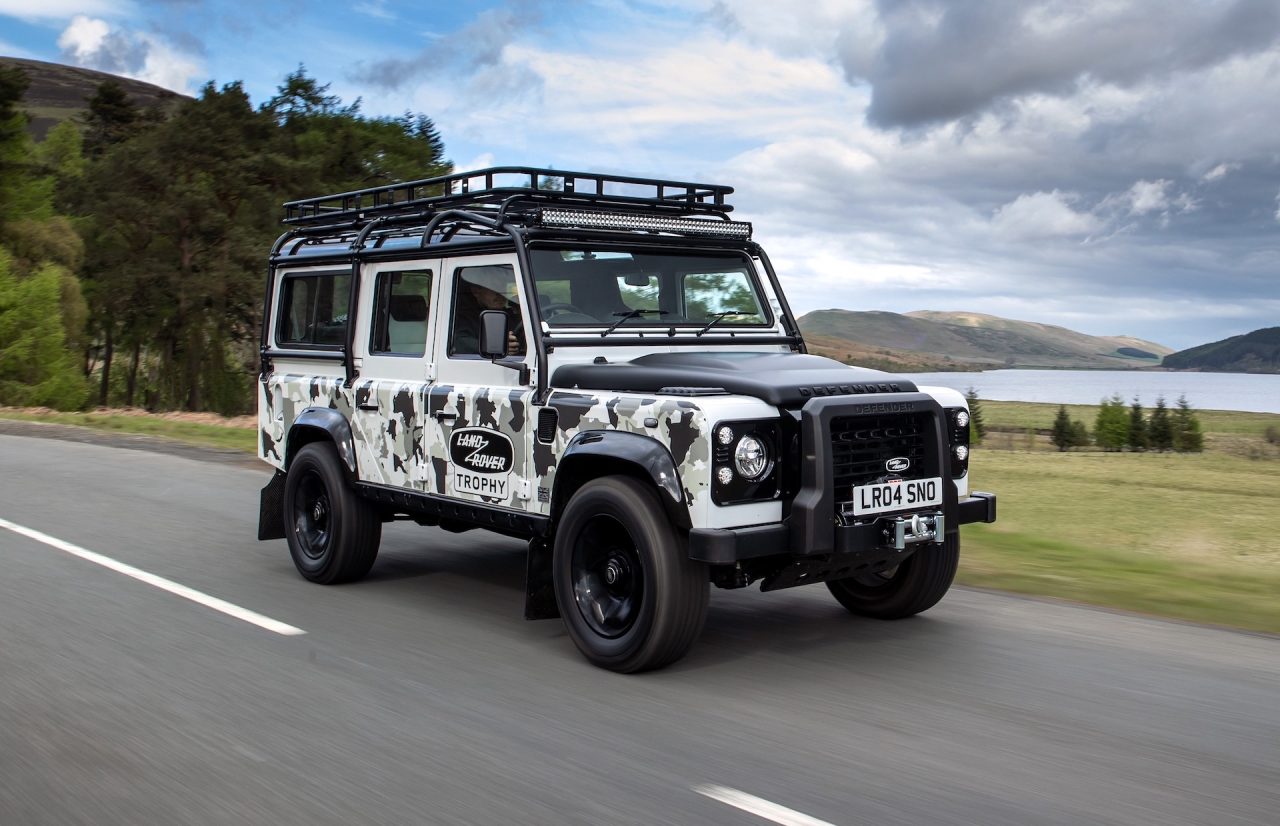It’s bigger, more practical and safer than before, but it’s also no quicker, uses more fuel and emits more emissions than the predecessor. Welcome to the all-new 2022 Subaru WRX. A vehicle that adopts the strangest form of evolution we’ve seen in a long while.
As a friendly warning, we are going to get right into the details and critique this car quite extensively and candidly. Because, this is a new generation WRX – a nameplate we’ve all cherished for decades. It is a big deal. Just like a new-gen Porsche 911 or even a new Toyota Camry, this is an important car, and one that has to be, for its intended purpose, better than its predecessors in every way.
For this test we’re looking at the WRX RS. Prices start from $50,490, but you can get into the base WRX manual from $44,990. Going for the CVT auto moves the prices up to $54,490 and $48,990, respectively (excluding on-road costs).
2022 Subaru WRX RS – THE SPECS
[column width=”47%” padding=”6%”]Engine: 2.4-litre turbo flat four-cylinder
Output: 202kW@5600rpm / 350Nm@2000-5200rpm
Transmission: Six-speed manual
Drive type: All-wheel drive, centre LSD
Wheels: F & R: 18×8.5, 245/40
ANCAP: Not tested
Tare weight: 1516kg
Power-to-weight: 7.50:1 (kg:kW)
Official fuel economy: 9.9L/100km
Economy during test: 10.2L/100km[/column] [column width=”47%” padding=”0″]Fuel capacity/Type: 63L/95 RON
Power efficiency: 20.40kW:L/100km
0-60km/h: 2.71 seconds*
0-100km/h: 5.93 seconds*
60-110km/h: 4.12 seconds*
1/4 mile: 14.08 seconds at 159.7km/h*
Max acceleration: 0.927g
100-0km/h braking: 2.84 seconds at 37.35 metres*
Max deceleration: -1.236g
Decibel at idle: 45*
Peak decibel at 60-100km/h: 82*
Priced from: $50,490[/column][end_columns]
* Figures as tested by PerformanceDrive on the day. Factory claims may be different
2022 Subaru WRX RS – THE PACKAGE
This spec on test here is essentially the flagship manual model. The new WRX wagon (previously called Levorg in Australia) is not available in manual form at all, sadly. Like all variants, the RS gets a big new portrait-style infotainment touch-screen packing Android Auto and Apple CarPlay, sat-nav, digital radio, and a beefy 10-speaker sound system. There’s even a CD changer in the centre console – what a throwback.
Subaru always does a great job when it comes to interior practicality. And the latest WRX is no different. The cabin is not only larger than most rivals, the arrangement of the controls, storage spots, and overall ergonomics are fantastic. These sports seats in the front offer a good mix of comfort and body-grabbing support too, and there’s plenty of adjustment available to find an ideal driving position. Even the steering column offers plenty of range in movement.
Rear seat accomodation is pretty good, although it’s disappointing there are no climate vents in the back of the console. Instead, the RS model comes with heated outer seats as standard, which are probably a bit useless in Australia. Twin charging ports are at hand though, and enough cup or bottle holders to keep everyone happy.
You’ve got a decent boot at the back (411L), good enough to pack for a weekend away or carry the weekly shopping, and this example shows off the awesome plastic mat accessory which is fully moulded to suit. Underneath it you’ll find a slightly narrower steel spare wheel (205 tyre).
Now, all of this sounds decent so far for the price. But we do have some concerns about this RS specification. The STI-branded tweaks found on the auto-only tS grade are not available in manual form. The tS grade comes with excellent adaptive dampers too – a first for the WRX. But you can only access them by opting for the boring CVT auto.
There is a lack of safety systems available on the manual compared with the auto as well; no lane departure warning, lane pre-collision braking, or reverse AEB, and more. Why, Subaru? We think this could be a much more appealing proposition if these options had been offered with the manual.
2022 Subaru WRX RS – THE DRIVE
One of the biggest changes for this new model is the introduction of Subaru’s ‘FA24F’ 2.4-litre turbo flat-four engine. It has been in use overseas in other models for a few years now, but here it is in its most powerful tune as far as we can see. The bore is larger compared with the old FA20, resulting in a favourable oversquare bore and stroke ratio (94mm x 86mm). The engine is actually pretty similar to the FA24D used in the new BRZ and Toyota GR86, but without Toyota’s D-4S port and direction injection combo.
Peak power is up by only 5kW compared with the old 2.0T, at 202kW, and torque remains unchanged at 350Nm. In our opinion, the engine should produce more torque, especially with its larger capacity than most four-cylinder motors. Instead, it relies on short-ratio gearing. It still feels very punchy in and exiting corners, but highway overtaking and top-end performance when loaded up is not as impressive as some rivals.
It’s lucky there is more to the new WRX than just acceleration. Because, using a Racelogic Vbox Sport and a private road we clocked a best 0-100km/h time of 5.93 seconds, which is fractionally better than Subaru’s official claim of 6.0 seconds. That’s not necessarily quick for a 200kW sports sedan with all-wheel drive on its side. For example, we’ve clocked a manual i30 N sedan in 6.00 seconds and the hatch in 6.09 seconds using the same equipment and tarmac. And they are front-wheel drive.
When the WRX was first launched as a stand-alone nameplate in Australia in 2013, Subaru gave it a 0-100km/h time of 6.0 seconds in manual form. And before that, when it was technically called the Impreza WRX, it came with a claimed 0-100km/h time of 5.7 seconds in base-spec manual form in 2003. And then 5.3 seconds in 2010. What happened here? We’d expect progress with evolution.
Well, as mentioned, there is a lot more to the new model than 0-100 times. The way it delivers its power and torque is much more linear and responsive than ever before. Peak torque, although unchanged at 350Nm, is spread between just 2000rpm and held until 5200rpm. That means you pretty much always have access to the meaty side of this new engine. In saying that, the previous 2.0T’s torque was spread between 2400-5200rpm; not a huge difference. Peak power is achieved at the same 5600rpm point as before.
There is something about having 400cc of additional combustion energy, though. It’s hard to explain but this new motor feels chunkier and more eager than the old unit. We suppose compression braking is also stronger as a result, even with the same 10.6:1 compression ratio as before. It feels like there is a reasonable amount of grunt available even before the turbo boost kicks in.
Speaking of which, the on-board turbo boost gauge maxes out at roughly 0.87bar (12.6psi). Although, we’ve seen some proper dyno tests with measurements taken directly from the manifold peaking at around 11.5psi. Either way, these are some very modest boost pressures, especially for a modern vehicle.
Why is the pressure so low? Well, the most obvious conclusion to draw is reliability. Subaru may have remained on the conservative side as a way of optimising longevity. For example, one of the most conservatively tuned factory cars on the market, the Toyota HiLux, runs a similar pressure with its 2.8 diesel. In terms of performance cars, like-minded rivals produce around 20psi, or up to 30psi in the case of the Mercedes-AMG A 45 S.
Okay, so maybe Subaru went for a mild tune for efficiency reasons? The manual sedan has an official average consumption rate of 9.9L/100km and an emissions average of 233g/km. The old 2.0T manual had a consumption rating of 8.6L/100km and produced 199g/km. So that’s a no, then. In the real world we averaged quite close to the official rating, returning a figure of 10.2L/100km over around 700km of driving. So that is pretty good.
Aside from the relatively underwhelming new engine, out in the corners is where this machine feels at home. The short gearing and forceful response catapult you from corner to corner. The steering is predictable and fun, with plenty of feedback letting you know how the 245/40 tyres are managing. The gear shift action is noticeably improved compared with past models, too. We tried a heap of acceleration runs and not once did we miss-shift – in the previous model it was quite notchy, especially going from second to third.
The ride comfort is okay on very bumpy roads. The suspension seems to absorb heavy impacts quite well. But over smaller bumps, particularly road connections and little potholes, it is uncomfortably loud and crashy – even compared with more serious hot hatches – resulting in an unpleasant drive in city conditions. This is where those adaptive dampers could have come in handy.
2022 Subaru WRX RS – THE VIDEOS
2022 Subaru WRX RS – THE VERDICT
Personally, I’m quite disappointed with this new model. It has clearly tried to hang onto its roots by being ‘chunky’ to drive and offering loads of mechanical grip. But then there have been some really stupid decisions in terms of specification; lack of advanced safety assist tech for the manual, no adaptive dampers or STI tS grade for the manual, and there’s a spanking-new larger capacity engine that produces the same torque (and very similar power) to the old 2.0T yet more emissions and higher fuel consumption. It doesn’t make sense.
If you really need AWD then this is a good one to consider. And of course if you’re clinging onto the WRX dream but haven’t been able to buy one until now, then, sure, this could be a great opportunity to rekindle. However, there are a number of quicker, more fuel efficient, cleaner (in terms of emissions), and more comfortable options in this class, available for similar money.
[column width=”47%” padding=”6%”]PROS:
– Big and practical inside
– Outstanding mechanical grip, can pull huge g-force in the corners
– Decent price for today’s market and level of features
– Big touch-screen and decent standard kit
[/column] [column width=”47%” padding=”0″]CONS:
– No adaptive dampers on manual; crashy ride in the city
– No lane-keep assist and other safety tech for manual
– Higher emissions and fuel consumption than before, same torque
– Feels overall like a new car from 5 years ago[/column][end_columns]
As always, if you’re thinking about buying a new car don’t forget to click here to speak with our car buying specialists.
